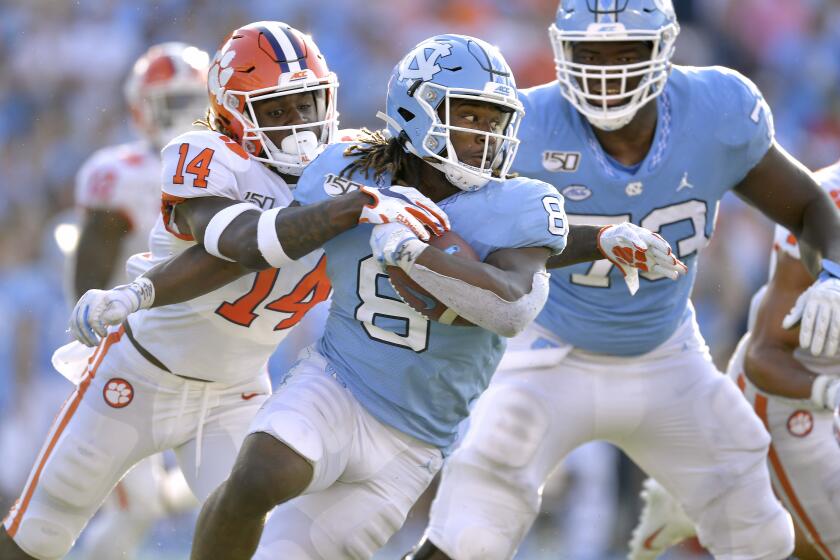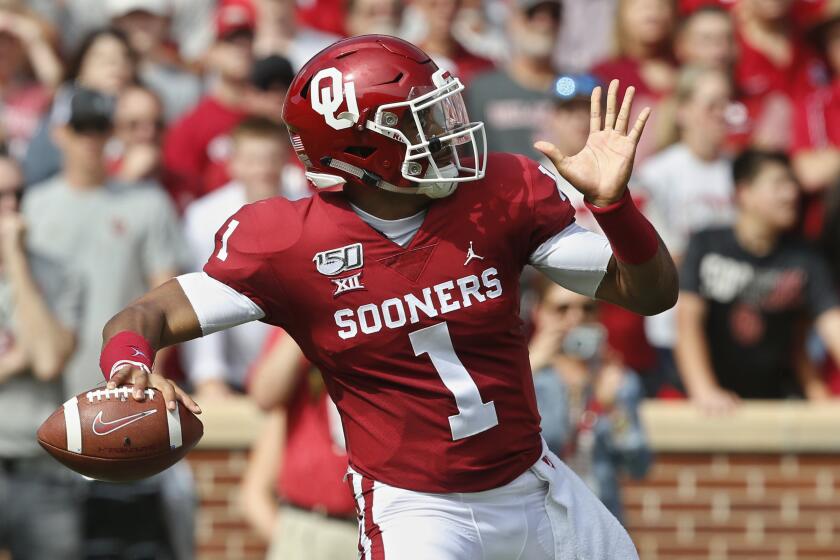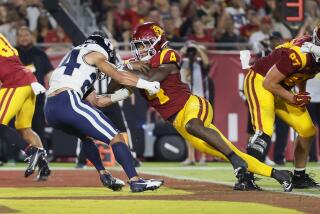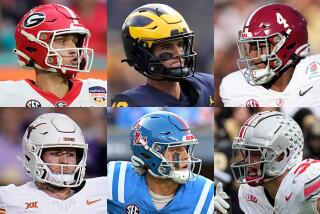Going for two and the win sounds good, but maybe not this time for Mack Brown
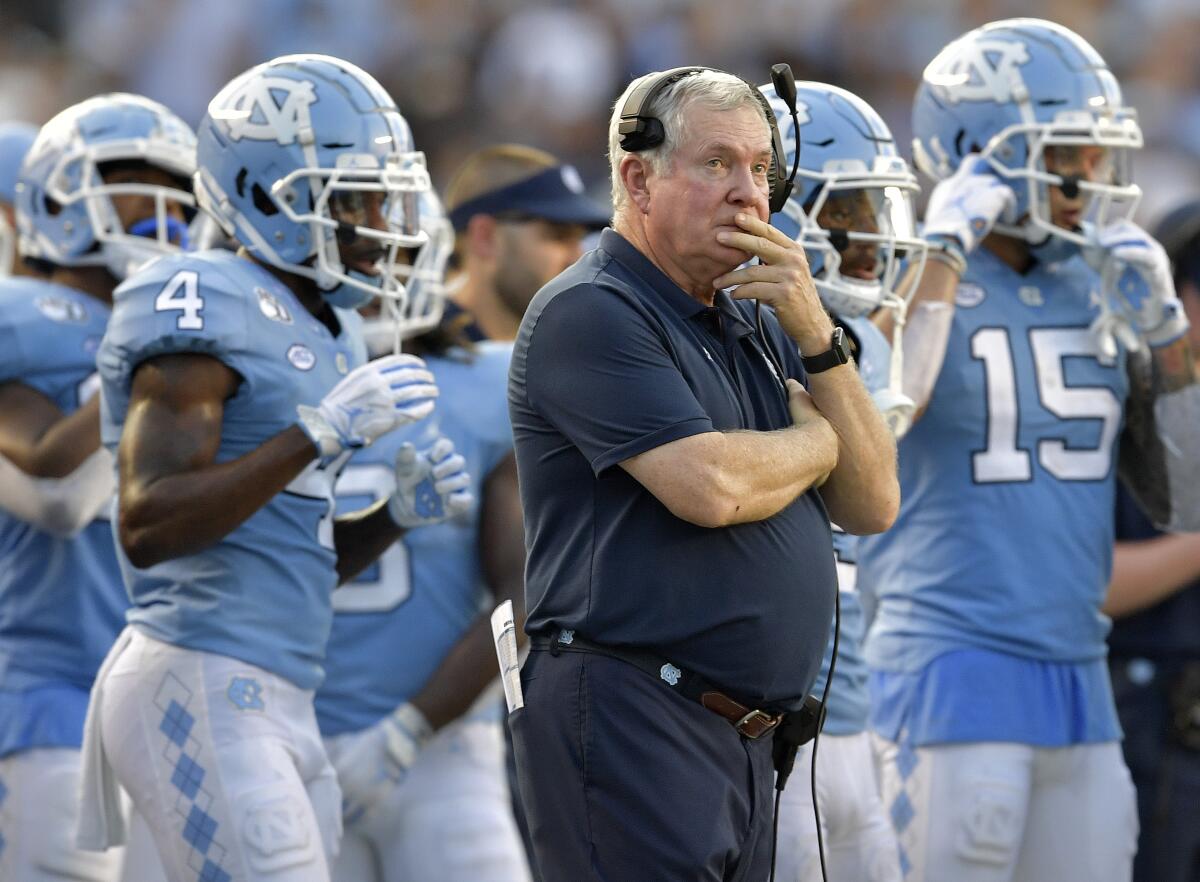
- Share via
Five games into his return to the sideline, Mack Brown’s inspired young North Carolina Tar Heels handed their grandfatherly head coach a scenario so fraught with emotional turmoil that even a lifetime of experience in this business wouldn’t easily solve it.
And yet, confronted with the decision to go for a two-point conversion to take a late lead over No. 1 Clemson or tie the score and trust his thriving defense to hold the Tigers and force overtime in Chapel Hill, Brown needed only a few seconds after North Carolina’s touchdown to throw his middle and index fingers into the air.
Two, it was.
In the five seasons since Brown unceremoniously resigned at Texas, “going for two and the win” has somehow become the conventional coaching logic, especially if the team with the ball is an underdog. Football coaches can be the most paranoid, risk-averse people on the planet most of the time, but give them one play from the two-yard line to either (potentially) win or (definitely) lose the game, and all of a sudden it feels like a no-brainer to sacrifice 60 minutes’ worth of work to the whims of the football gods.
It’s clear why Brown felt he had nothing to lose and everything to gain here. He’s in his first season back at North Carolina, so there is no outside pressure. It’s all fun for now, and good for him for enjoying that freedom after so many agonizing autumns in Austin. The Tar Heels, who started the season as one of the sport’s best stories with comeback wins over South Carolina and Miami, fell flat with losses at Wake Forest and at home to Appalachian State. And they were 27-point underdogs to the defending national champion Tigers, who came into the game winners of 19 in a row.
I get Brown’s bravado, but I didn’t agree with it, even before North Carolina’s questionable play design blew up in its face — quarterback Sam Howell faked a handoff, kept the ball and had an option to keep the ball or pitch it outside to receiver Dazz Newsome. Against Clemson’s fleet-footed defense, the play never had a chance.
Clemson stuffed North Carolina’s 2-point conversion attempt with 1:17 left and the No. 1 Tigers held off the Tar Heels 21-20.
Of course it’s easy to be critical after the fact. If Brown’s big gamble pays off, the Tar Heels are national darlings and have a win that they’ll remember for the rest of their lives. What a story that would have been. But I truly believe North Carolina had a better shot at that happening by tying the score at 21 with 1:17 left and playing it out.
And I’ll admit, as an obsessive observer of college football, I’m probably being a bit selfish. I just wanted to live with the fantasy of Clemson being upset and a new team having a better shot at grabbing a spot in the College Football Playoff for longer than zero seconds of elapsed time.
The emotions of the moment were overpowering. But here were the facts: North Carolina had played Clemson even the entire game. The Tigers, with all of that talent and pedigree, had only a 331-290 advantage in total yards. Each team had 14 first downs. North Carolina held a slight edge in time of possession. The Tar Heels, playing in front of a rowdy home crowd, didn’t feel like huge underdogs by the end.
Plus, “going for two and the win” wasn’t an accurate description of the scenario. Even if North Carolina had seized a 22-21 lead, there was still plenty of time for Clemson and quarterback Trevor Lawrence to drive the field for a touchdown or game-winning field goal, and they would have had four downs to do it.
If the game had been tied, it’s likely that Clemson would have played its final drive more conservatively, knowing that the worst that could happen for it was going to overtime unless it turned the ball over and gave North Carolina field position.
FiveThirtyEight.com, an ESPN website with statistical data analysis that covers everything from college football to the presidential election, produced a detailed breakdown of all the scenarios in which it makes sense for a coach to go for two based on the numbers. Being down by one late did not make the list.
“Toward the end of the game, remaining time becomes an extremely important factor,” the article said. “In particular, when your opponent is likely to get another possession and your team is not, going for two becomes something a coach probably shouldn’t do.”
Mack Brown made this call based on feel alone. And he has nothing to feel bad about, really. It was still an awesome college football game, and his program is in fine shape as it looks to the future. But, ultimately, North Carolina lost, and the rest of the country felt it too.
With a loss, Clemson would have taken a major blow to its repeat hopes. Sure, the Tigers could have still ended up in the CFP with one loss, but they probably would have had to make it through the committee’s process despite having no good wins and a bad loss. Two Southeastern Conference teams, one of Ohio State, Penn State and Wisconsin and one of Oklahoma or Texas as one-loss teams at the end would all have better resumes than Clemson would.
This two-and-the-win decision is going to come up again and again. It just so happens that, this time, it had a major effect on the national championship race. Sometimes, the math and the game flow will dictate that an underdog should take its shot at the win. Brown had his reasons, but this particular scenario deserved more reservation from a coach who’s seen it all.
Notre Dame ‘D’ rises up
No. 10 Notre Dame stayed nationally relevant Saturday afternoon with a 35-20 win over No. 18 Virginia in South Bend.
The Fighting Irish, coming off a 23-17 loss at Georgia, looked to be in deep trouble when Virginia, leading 17-14, got the ball back on a surprise onside kick to start the second half.
That’s when Notre Dame’s defensive front took the game over, harassing Virginia quarterback Bryce Perkins the rest of the day and forcing two fumbles, one of which the Fighting Irish took back for a touchdown.
Notre Dame’s offense with quarterback Ian Book remains a work in progress, but the Fighting Irish defense looks like it will give them a legitimate shot at running the table.
Recaps and scores of the top 25 college football teams in action.
Tua’s No. 3
Imagine being Alabama quarterback Tua Tagovailoa and having Jerry Jeudy, the reigning Fred Biletnikoff Award winner as the top receiver in the country, and not even having to look his way for most of an afternoon.
On Saturday, in a 59-31 win over Mississippi, Tagovailoa connected with Devonta Smith 11 times for 274 yards and five touchdowns, both school records.
Smith is supposed to be Alabama’s third wide receiver behind Jeudy and Henry Ruggs III. That’s just unfair.
Surprise unbeaten teams
Wake Forest, Baylor, and Minnesota are the remaining undefeated teams from Power Five conferences that are not ranked. Which is best positioned to become a fun story well into the next month?
Wake Forest, led by emerging star quarterback Jamie Newman, has three straight winnable home games — Louisville, Florida State and N.C. State — followed by a winnable road game at Virginia Tech. The Demon Deacons could feasibly be 9-0 and approaching the top 10 when they visit Clemson on Nov. 16.
Minnesota, while not winning impressively thus far, also has the schedule to do it. Three of the next four are home games against Illinois, Nebraska and Maryland. The road game? Rutgers. It would not be that shocking for the Golden Gophers to be 8-0 when No. 12 Penn State visits Nov. 9.
Baylor has a rougher path with road games coming up at Kansas State and Oklahoma State.
More to Read
Go beyond the scoreboard
Get the latest on L.A.'s teams in the daily Sports Report newsletter.
You may occasionally receive promotional content from the Los Angeles Times.

